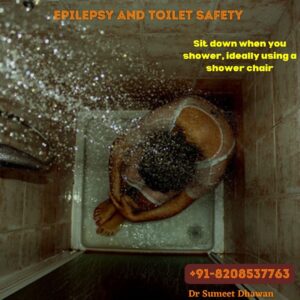Do take these precaution to prevent serious injuries during seizures










Prioritizing Safety: A Guide to Toilet Safety for People with Epilepsy
Epilepsy can present safety challenges in everyday situations, and using the bathroom is no exception. Fortunately, by implementing some simple strategies, you can significantly enhance toilet safety for yourself or a loved one with epilepsy. This guide explores potential risks, practical solutions, and valuable resources to create a safer bathroom environment.
Understanding the Risks
During a seizure, a person may lose consciousness, balance, or muscle control. This can increase the risk of falls, injuries, and drowning in the case of bathtubs. Here’s a breakdown of the potential dangers:
- Falls: Loss of balance or muscle control during a seizure can lead to falls, especially near slippery surfaces like bathtubs and showers.
- Head Injuries: Falls can result in head injuries, which can be particularly serious for people with epilepsy.
- Drowning: In bathtubs, unconsciousness during a seizure can increase the risk of drowning.
Creating a Safe Bathroom Environment
Here are some practical steps to improve toilet safety for people with epilepsy:
- Install Grab Bars: Strategically placed grab bars near the toilet, shower, and bathtub can provide essential support and prevent falls.
- Consider a Shower Chair: Using a sturdy shower chair with a back and armrests minimizes the risk of falls in the shower.
- Invest in Non-Slip Mats: Place non-slip bath mats in the tub and shower to create a secure footing.
- Remove Bath Mats When Not in Use: Wet bath mats can be slippery hazards, so remove them when not in use to prevent falls.
- Lower the Toilet Seat (if possible): For some individuals, a raised toilet seat might be helpful, but if falls are a concern, consider a lower toilet seat for easier access and safer positioning.
- Secure Toiletries: Securely store toiletries on shelves or cabinets to prevent them from falling and causing injuries during a seizure.
- Door Considerations: Ensure bathroom doors open outwards to allow for easy access in case of a fall or emergency. Consider replacing locking mechanisms with easy-to-open options from the outside.
- Nightlight: A nightlight can help prevent disorientation and falls, especially during nighttime bathroom visits.
Additional Safety Tips
- Don’t Lock the Door: Avoid locking the bathroom door. Consider using an “occupied” sign instead to maintain privacy while allowing for easy access in case of an emergency.
- Inform Others: Let someone you trust know when you’re using the bathroom, especially if you live alone.
- Consider Medical Alert Devices: Explore options like medical alert bracelets or necklaces that can summon help in case of a seizure.
Remember:
- Individual needs can vary. Consult with an occupational therapist or healthcare professional to determine the most suitable safety measures for your specific situation.
- Prioritize Comfort and Independence: While safety is paramount, strive to create a balance by maintaining a level of independence and comfort in the bathroom environment.
SEO Optimization:
- Relevant keywords like “toilet safety,” “epilepsy,” “bathroom safety tips,” and “seizure safety” are incorporated naturally within the content.
- Title tags, meta descriptions, and image alt tags can be further optimized using these keywords for better search engine visibility.
- Internal linking to other relevant blog posts on your website (if applicable) can improve website navigation and user experience.
By prioritizing safety and implementing these practical strategies, you can create a bathroom environment that minimizes risks and fosters peace of mind for people with epilepsy.
Additional Resources:
- Epilepsy Foundation: https://www.epilepsy.com/
- Centers for Disease Control and Prevention: https://www.cdc.gov/epilepsy/index.html
- National Institute of Neurological Disorders and Stroke: https://www.ninds.nih.gov/